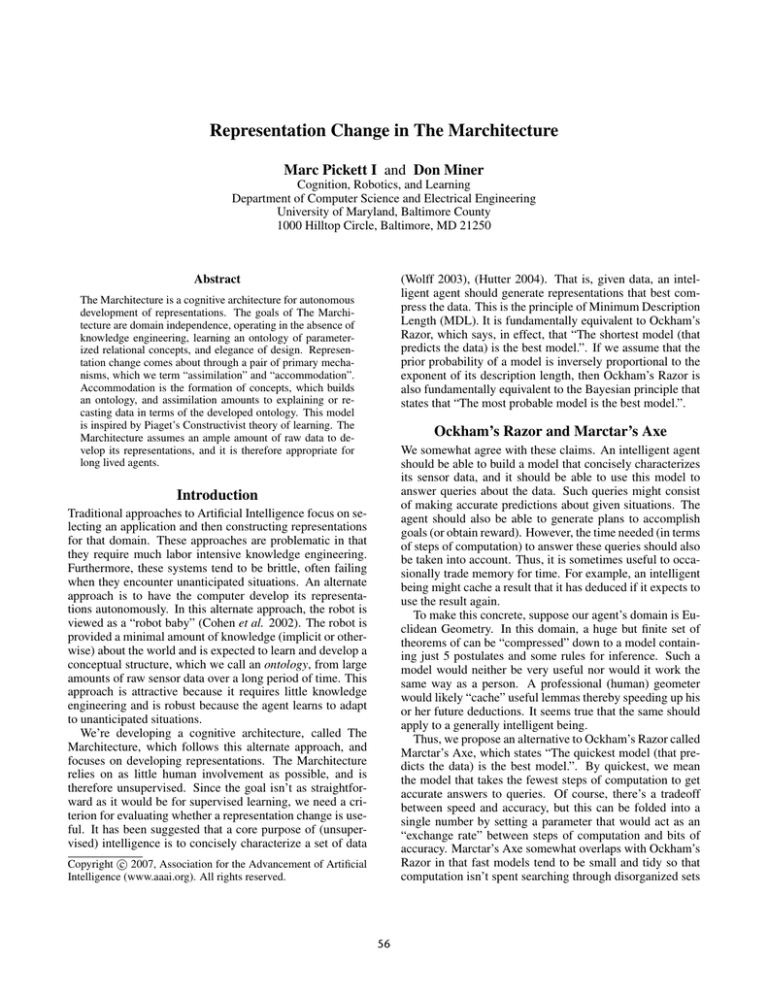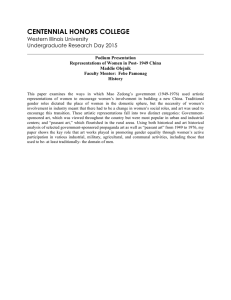
Representation Change in The Marchitecture
Marc Pickett I and Don Miner
Cognition, Robotics, and Learning
Department of Computer Science and Electrical Engineering
University of Maryland, Baltimore County
1000 Hilltop Circle, Baltimore, MD 21250
(Wolff 2003), (Hutter 2004). That is, given data, an intelligent agent should generate representations that best compress the data. This is the principle of Minimum Description
Length (MDL). It is fundamentally equivalent to Ockham’s
Razor, which says, in effect, that “The shortest model (that
predicts the data) is the best model.”. If we assume that the
prior probability of a model is inversely proportional to the
exponent of its description length, then Ockham’s Razor is
also fundamentally equivalent to the Bayesian principle that
states that “The most probable model is the best model.”.
Abstract
The Marchitecture is a cognitive architecture for autonomous
development of representations. The goals of The Marchitecture are domain independence, operating in the absence of
knowledge engineering, learning an ontology of parameterized relational concepts, and elegance of design. Representation change comes about through a pair of primary mechanisms, which we term “assimilation” and “accommodation”.
Accommodation is the formation of concepts, which builds
an ontology, and assimilation amounts to explaining or recasting data in terms of the developed ontology. This model
is inspired by Piaget’s Constructivist theory of learning. The
Marchitecture assumes an ample amount of raw data to develop its representations, and it is therefore appropriate for
long lived agents.
Ockham’s Razor and Marctar’s Axe
We somewhat agree with these claims. An intelligent agent
should be able to build a model that concisely characterizes
its sensor data, and it should be able to use this model to
answer queries about the data. Such queries might consist
of making accurate predictions about given situations. The
agent should also be able to generate plans to accomplish
goals (or obtain reward). However, the time needed (in terms
of steps of computation) to answer these queries should also
be taken into account. Thus, it is sometimes useful to occasionally trade memory for time. For example, an intelligent
being might cache a result that it has deduced if it expects to
use the result again.
To make this concrete, suppose our agent’s domain is Euclidean Geometry. In this domain, a huge but finite set of
theorems of can be “compressed” down to a model containing just 5 postulates and some rules for inference. Such a
model would neither be very useful nor would it work the
same way as a person. A professional (human) geometer
would likely “cache” useful lemmas thereby speeding up his
or her future deductions. It seems true that the same should
apply to a generally intelligent being.
Thus, we propose an alternative to Ockham’s Razor called
Marctar’s Axe, which states “The quickest model (that predicts the data) is the best model.”. By quickest, we mean
the model that takes the fewest steps of computation to get
accurate answers to queries. Of course, there’s a tradeoff
between speed and accuracy, but this can be folded into a
single number by setting a parameter that would act as an
“exchange rate” between steps of computation and bits of
accuracy. Marctar’s Axe somewhat overlaps with Ockham’s
Razor in that fast models tend to be small and tidy so that
computation isn’t spent searching through disorganized sets
Introduction
Traditional approaches to Artificial Intelligence focus on selecting an application and then constructing representations
for that domain. These approaches are problematic in that
they require much labor intensive knowledge engineering.
Furthermore, these systems tend to be brittle, often failing
when they encounter unanticipated situations. An alternate
approach is to have the computer develop its representations autonomously. In this alternate approach, the robot is
viewed as a “robot baby” (Cohen et al. 2002). The robot is
provided a minimal amount of knowledge (implicit or otherwise) about the world and is expected to learn and develop a
conceptual structure, which we call an ontology, from large
amounts of raw sensor data over a long period of time. This
approach is attractive because it requires little knowledge
engineering and is robust because the agent learns to adapt
to unanticipated situations.
We’re developing a cognitive architecture, called The
Marchitecture, which follows this alternate approach, and
focuses on developing representations. The Marchitecture
relies on as little human involvement as possible, and is
therefore unsupervised. Since the goal isn’t as straightforward as it would be for supervised learning, we need a criterion for evaluating whether a representation change is useful. It has been suggested that a core purpose of (unsupervised) intelligence is to concisely characterize a set of data
c 2007, Association for the Advancement of Artificial
Copyright Intelligence (www.aaai.org). All rights reserved.
56
also useful for knowledge transfer: if an analogy is found,
then conclusions about one domain can map to another domain.
The Marchitecture uses analogy discovery to form its concepts in a manner similar to the SUBDUE system (Holder,
Cook, & Djoko 1994). The Marchitecture represents its data
in a relational format and searches for frequently occurring
subgraphs, which become candidates for becoming concepts
(depending on its potential to reduce description length or
query time). When a subgraph is selected to become a concept, it becomes parameterized. For example, the concept of
“stealing” might have the parameters “thief”, “victim” and
“stolen”.
These parameterized concepts allow us to unify the processes of classification and explanation (which we call assimilation) because we can use these concepts as rules similar to those used in logic programming. The Marchitecture
uses a top-down/bottom-up process of explanation which
is inspired by the model of the neocortex described by
(Hawkins & Blakeslee 2004).
of information. Marctar’s Axe also addresses the utility of
caching: caching the answers to frequent queries (or frequent “way points” in derivations) can yield a faster model.
Relational Representations
If The Marchitecture is to acquire human level intelligence,
it will need to be able to represent and learn relational concepts (e.g., “cousin”, “above”, or “enemy”). Relational concepts are a form of invariant representations since they can
have ground instances that vary widely. We suspect that such
representations are necessary for solving a wide range of
problems. For example, when a person dons a pair of greentinted sunglasses for the first time, they have little trouble
adapting to their altered visual input, but this isn’t such a
trivial task for a (visual) robot. In terms of raw sensor data,
a green-tinted scene has very different values from the same
scene in its natural color. Representations developed from
visual data should also be invariant to translation, rotation,
and scaling. These invariant representations aren’t limited
to visual data. A stenographer can hear different speakers say the same phrase in different pitches, volumes, and
speeds, yet produce the same transcription.
Outlook
By focusing on development of representations, we believe
we’ve addressed problems with acquiring knowledge, and
that we’ve developed the basis for a full cognitive architecture. Using this basis, The Marchitecture tightly integrates
other aspects of cognition not discussed here. For example,
meta-cognition, planning, and reasoning. The strength of
The Marchitecture lies in its simplicity and in its focus on
development of representations. To guard against domain
dependence, we have a set of disparate domains on which to
test The Marchitecture. Our goal is to apply our algorithm
to RISK, Conway’s Life, robot sonar data, and a traffic simulation domain.
Piaget’s Constructivist Theory of Learning
Whether in terms of Ockham’s Razor or Marctar’s Axe, the
goal of The Marchitecture is to characterize its input data,
and forming concepts and building an ontology are means
to this end. However, for concepts to be helpful, the data
needs to be expressed in terms of these concepts. For example, having developed the concept of “a duck”, we should
be able to recognize an instance of a duck and classify it
as such. Doing this prevents us from having to redescribe
all the attributes that a duck has every time we see one, so
this “shorthand” process is useful for minimizing description length. It’s also useful for quickly answering queries
because, for example, knowing that ducks lay eggs, we can
quickly answer whether a particular duck lays eggs.
Inspired by Piaget’s Constructivist theory of learning (Piaget 1954), we call the process of developing concepts “accommodation”, and the process of using these concepts to
classify or explain data “assimilation”. The Marchitecture
further follows Piaget’s theory in that, when encountering
new data, it first attempts to explain the data using the current ontology. If it’s unsuccessful, it sets the unexplained
data aside and periodically looks for patterns in its set of unexplained data out of which it can form new concepts. When
a new concept is formed, The Marchitecture attempts to use
this to explain the previously unexplained data.
Some suggest that analogy may be the “core of cognition” (Hofstadter 2001). Analogy allows us to focus on the
relations among entities rather than superficial aspects of the
entities. For example, we might notice that a red ant killing
a black ant and stealing a piece of food it is analogous to a
situation in Hamlet where Claudius murders Hamlet’s father
and usurps the throne of Denmark. In this situation binding
is important. That is, we must be able to specify that the
red ant corresponds to Claudius, the black ant to Hamlet’s
father, and the piece of food maps to the throne. Analogy is
References
Cohen, P.; Oates, T.; Beal, C.; and Adams, N. 2002. Contentful Mental States for Robot Baby. In Proceedings of
the 18th National Conference on Artificial Intelligence.
Hawkins, J., and Blakeslee, S. 2004. On Intelligence.
Times Books.
Hofstadter, D. R. 2001. Analogy as the Core of Cognition.
The Analogical Mind: Perspectives from Cognitive Science
499–538.
Holder, L.; Cook, D.; and Djoko, S. 1994. Substructure
Discovery in the SUBDUE System. In Proceedings of the
Workshop on Knowledge Discovery in Databases.
Hutter, M. 2004. Universal Artificial Intelligence: Sequential Decisions based on Algorithmic Probability. EATCS.
Berlin: Springer.
Piaget, J. 1954. The Construction of Reality in the Child.
Basic Books.
Wolff, J. G. 2003. Information Compression by Multiple
Alignment, Unification and Search as a Unifying Principle
in Computing and Cognition. Artif. Intell. Rev. 19(3):193–
230.
57






